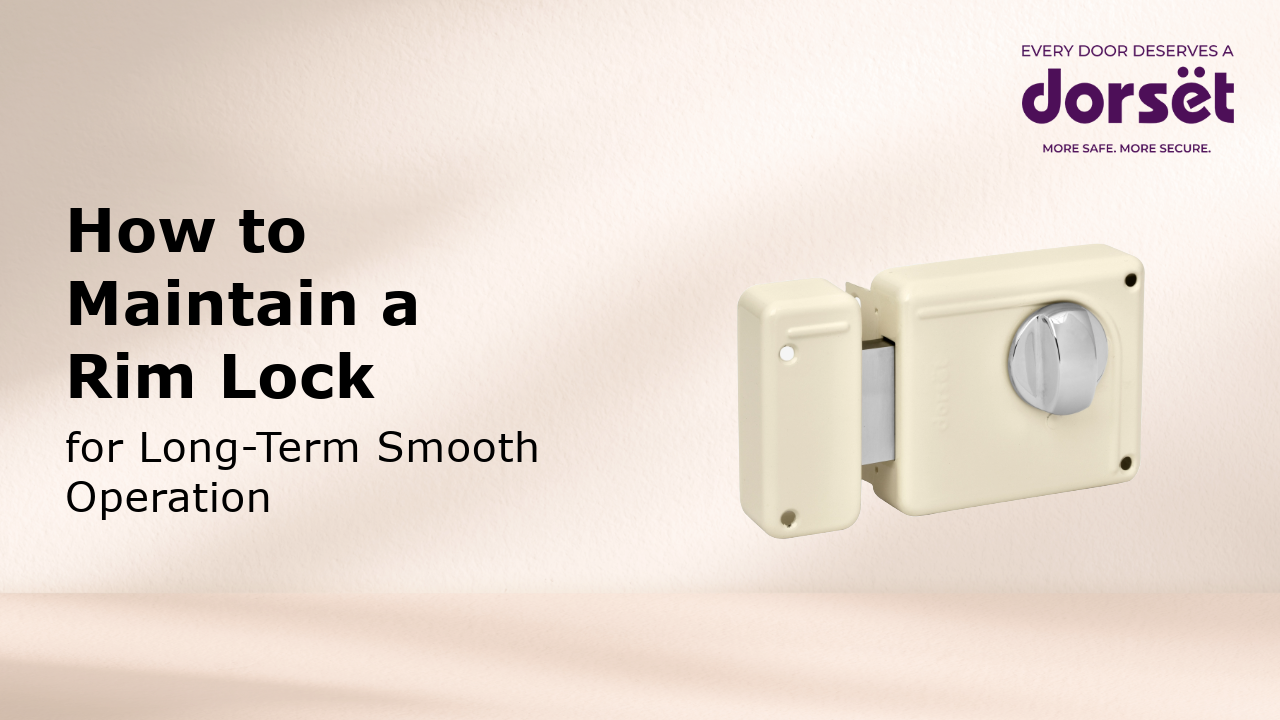
That satisfying "click" when your rim lock engages is music to our ears at Dorset. We know that traditional mechanical rim locks aren't just functional, they're often beautiful pieces of hardware that add character to your home. But like any mechanical device, they need proper care to keep working smoothly year after year. Let's walk through how you can maintain your rim lock for decades of reliable service.
Understanding Your Rim Lock
Before diving into maintenance, it helps to understand what you're working with. Rim locks are surface-mounted on the door (rather than mortised into it), making them more accessible for DIY maintenance. Whether you have a traditional night latch, a triolock with both-side key operation, or a deadbolt lock system, the maintenance principles remain similar.
Most rim locks consist of:
- The lock body (mounted on the inside of the door)
- The striking plate (attached to the door frame)
- The keyhole and cylinder (on the exterior side)
- Various internal springs, levers, and mechanisms
Each of these parts needs attention for your lock to function properly over time.
Your Seasonal Maintenance Checklist
We recommend a simple maintenance routine twice a year. Here's what your seasonal checklist should include:
- Clean out any dust and debris from the keyhole using compressed air
- Check and tighten any loose screws on both the lock body and strike plate
- Apply a small amount of appropriate lubricant (more on this below)
- Test the operation several times to ensure smooth function
- Inspect for signs of wear or damage
This 10-minute ritual can prevent most common lock problems and extend the life of your hardware considerably.
The Lubrication Question: What to Use (And What to Avoid)
Proper lubrication is where many homeowners go wrong. You might be tempted to reach for WD-40, but we'd advise against it for long-term lock maintenance. While it's great for loosening stuck components, it's not ideal as a regular lubricant for locks.
Instead, consider these options:
- Graphite powder: This dry lubricant is perfect for the internal mechanisms and keyways. It won't attract dust or gum up like oil-based products.
- Silicone-based lubricant: A good alternative to graphite, especially in humid environments.
- Specific lock lubricants: Products designed specifically for locks provide optimal performance.
What you should NEVER use:
- Cooking oils or greases (they become sticky and attract dirt)
- General-purpose household oils (they can build up and cause issues over time)
- Petroleum jellies (they can deteriorate certain parts)
Apply lubricant sparingly. A little goes a long way. Too much lubricant can actually attract more dirt and cause problems down the road.
Troubleshooting Common Issues Before They Worsen
Regular maintenance helps you spot potential problems before they become major headaches. Here are common issues to watch for and address early:
- Stiff operation: Usually indicates a need for cleaning and lubrication
- Key sticking: Could be worn keys or debris in the keyway
- Misalignment: Often caused by loose mounting screws or door movement
- Intermittent locking: Typically springs or internal parts needing attention
When you notice these early warning signs, don't wait. Address them promptly to prevent further damage or potential lockouts.
Seasonal Considerations for Your Rim Lock
Your maintenance approach should adapt to the seasons:
Spring/Summer:
- Check for expansion issues as humidity increases
- Ensure strike plates remain perfectly aligned as doors swell slightly
- Clean out any pollen or seasonal debris that might enter the mechanism
Fall/Winter:
- Apply fresh lubricant before temperatures drop
- Check weather stripping around the door that might affect lock alignment
- Ensure the mechanism moves freely as colder temperatures can cause stiffness
When DIY Isn't Enough, Call a Professional
While we're big fans of DIY maintenance, there are times when professional help is warranted:
- If the lock suddenly stops working completely
- When you notice significant internal damage or broken parts
- If the key breaks inside the cylinder
- When security has been compromised
Professional locksmiths have specialised tools and parts that can address these more serious issues.
Extending the Life of Your Keys
Your keys are half of the locking equation, and their maintenance matters too:
- Have duplicate keys made before originals show significant wear
- Store spare keys in a dry location to prevent corrosion
- Clean keys occasionally with a soft cloth to remove oils and debris
- Avoid using keys for other purposes (like box cutters or pry tools)
Well-maintained keys put less stress on your lock's internal parts, extending the life of both.
Preserving the Finish of Your Rim Lock
The appearance of your rim lock contributes to your home's character. Different finishes require different care:
- Nickel Silver/Chrome: Clean with a soft cloth slightly dampened with water, then buff dry
- Antique/Brass Finishes: Use specific metal polishes designed for these finishes
- Matte Finishes: Simply dust regularly and avoid abrasive cleaners
Avoid harsh chemical cleaners that can damage decorative finishes or remove protective coatings.
The Final Word
At Dorset, we believe that proper lock maintenance is becoming something of a lost art in our society. When you maintain a quality rim lock, you're not just saving money, you're preserving a piece of functional craftsmanship.
Whether you have our traditional night latch models, triolocks with their robust security features, or deadbolts providing that extra peace of mind, proper maintenance ensures they'll continue protecting your home for years to come.
Now go give that rim lock some attention. Your future self will thank you when it's still clicking smoothly years from now!